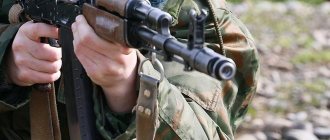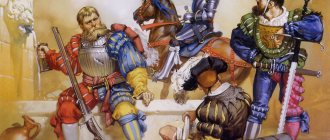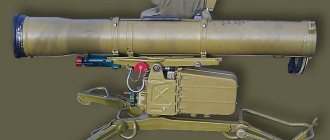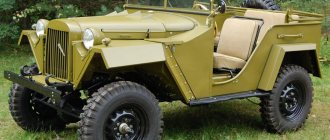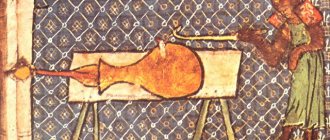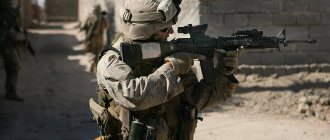The first weapons, apparently, appeared back when man was not quite human. Even Australopithecus or Pithecanthropus needed to defend themselves with something from predatory animals that were constantly trying to devour him (or, for example, hit a gaping fellow tribesman on the head to take food away from him). So a stone or a stick in the hands of our distant ancestor is also, in fact, a weapon.
Further more. The more a person moved along the “historical scale,” the more complex (and deadly!) weapons became.
But now we will not talk about the latest innovations developed for the modern military, but about rather ancient types of various gizmos designed to inflict physical damage on the enemy. Or rather, about the most outwardly unusual of them.
We are accustomed to thinking that in ancient times and during the Middle Ages they mainly used knives, swords, spears, axes, and bows and arrows. Now look how inexhaustible human imagination was when it came to weapons.
Khopesh
Khopesh is a type of bladed weapon of Ancient Egypt with a sickle-shaped blade. In form and functionality it is something between a sword and an ax. Khopesh quite successfully combines the features of both of these weapons - with this weapon you can chop, cut, stab.
The first mention of it appears in the New Kingdom, the last - around 1300 BC. e. Most often, the khopesh worked like an ax; in practice, it is impossible to stop its blow with a blade alone - it breaks through.
Kpinga
But kpinga is an African weapon. It was used in the territory of Nubia (this is the north of present-day Sudan and the south of Egypt) by warriors of the Azanda tribe.
In fact, this is a kind of “irretrievable” boomerang, which was used in a very similar way: the kpinga was thrown horizontally towards the enemy formation and, since this throwing knife has a specific shape and several blades (usually at least three), even shields were of little help from it , – the kpinga could jump to the side of a nearby warrior or, turning over the edge of the shield, still cripple its owner.
By the way, thanks to the “configuration” this weapon was convenient to carry on the shoulder. And in fact, kpinga was used, most often, only when all the spears and arrows were used up (after all, metal is expensive).
Kakute
A fighting ring or kakute is a non-lethal type of Japanese weapon, which consists of a small hoop encircling the finger and riveted/welded spikes (usually from one to three).
A warrior usually wore one or two rings - one on the middle or index finger and the other on the thumb. Most often, rings were worn with the spikes inward and were used in cases where it was necessary to capture and hold a person, but not kill him or cause deep damage. However, if the kakute were turned with their spikes outward, they turned into serrated brass knuckles.
The goal of the kakute was to subdue the enemy, not to kill him. These fighting rings were especially popular among kunoichi - female ninjas. They used poison-coated kakute for quick, fatal attacks.
Naginata
Actually, the naginata was invented by the Chinese, but this type of weapon became most widespread, again, in Japan. It is a shortened (on average 50-70 cm) and slightly curved blade, similar to a classic (but more massive) Japanese sword, mounted on a long (150-180 cm) shaft.
The naginata was used by both ordinary infantrymen (firstly, it made it possible not to let the enemy get too close, and secondly, on the contrary, to reach the retreating enemy), and more noble warriors - they cut the legs of enemy horses with it in battle.
In addition, in peacetime, this type of weapon was used to protect their homes by women from the samurai class. In the XVII-XVIII centuries. All women from samurai families were required to master the naginata by the age of 18.
Shuangou
Shuangou is a sword with a hook-shaped tip, a dagger-shaped pommel and a sickle guard. As a result, a warrior armed with such a strange weapon was able to fight at different distances, both close and at a distance from the enemy at the distance of the tip of a sword.
The front part of the blade, the concave part of the guard, the pommel of the handle and the outer side of the hook were sharpened. Sometimes the inner side of the hook was not sharpened, which made it possible to grab this part of the weapon and strike like an ax with the same “moon-shaped guard.”
All this variety of blades made it possible to combine techniques both at long range and close. With a dagger handle you can hit with reverse movements, with a sickle - with a guard, you can not only cut the enemy, but also hit with brass knuckles.
The toe - the hook of the sword made it possible not only to hit with chopping or cutting movements, but also to catch the enemy, grab limbs, cut, clamp and block the weapon, or even pull it out. It was possible to hook the shuangou with hooks, and thus suddenly increase the attack distance.
Urumi
Urumi literally means "twisted blade". This Indian weapon is a kind of very flexible (and very long - from 1.5 to 6 meters) sword, which can be hidden under clothing in the form of a belt.
Externally, the urumi is simply a thin steel strip with a hole at the end, attached to a wooden handle. It can be wrapped around the waist and “fastened” to the same hole.
Of course, handling this weapon is very difficult, because you can cause serious damage to yourself (especially when used in a cramped environment).
Therefore it was never widespread. But masters who mastered urumi perfectly were considered great warriors, since these weapons (and sometimes they had up to 10-12 blades at once) were very difficult to defend against.
Zhua
Another Chinese weapon. The iron “hand” of Zhua was a long stick, at the end of which was attached a copy of a human hand with huge claws that easily tore pieces of flesh from the body of opponents. The weight of the zhua itself (about 9 kg) was enough to kill the enemy, but with claws everything looked even more terrible. If the zhua was used by an experienced warrior, he could pull soldiers off their horses. But the main goal of the Zhua was to snatch shields from the hands of opponents, leaving them defenseless against the deadly claws.
Unique Chinese crossbow
Before the conflict with Japan (1894-1895), the warriors of China were equipped with a unique and very formidable weapon of that time - the cho-ko-nu repeating crossbow. This product used tension and release of the bowstring. The entire structure worked with one hand: the bowstring was pulled, the bolt fell into the barrel and the release was made. Cho-ko-nu was a very effective and fast weapon: within twenty seconds, a Chinese warrior could fire about ten arrows. The distance for which this crossbow was intended reached 60 meters. In terms of its penetrating ability, cho-ko-nu gave low indicators. But at the same time, the weapon had high speed. Various poisons were often applied to the arrow tips, which made the cho-ko-nu a truly deadly weapon. If we compare this ancient Chinese product with modern similar models, then in its simplicity of design, rate of fire and ease of use, the cho-ko-nu has much in common with the Kalashnikov assault rifle.
Skissor
In essence, it is a metal sleeve that ends with a semicircular point. Served for protection, successfully blocking enemy blows, and also for delivering your own blows. The wounds from the scissor were not fatal, but very unpleasant, leading to heavy bleeding. The scissor was light and had a length of 45 cm. The first to use the scissor were Roman gladiators, and if you look at the images of these battles, you can definitely distinguish the scissor from most warriors.
Yawara
Yavara is, in fact, the simplest brass knuckles without finger protection. Medieval Japan was a very harsh place: ordinary peasants and artisans were nothing here, and anyone could (and had every right) attack them.
And since metal was too expensive, representatives of the lower strata of the population simply could not afford to have real weapons. And they found a way out: an ordinary wooden cylinder 12-15 cm long and up to 3 cm in diameter fits perfectly in the hand.
And if its ends are also sharpened, then, in combination with the Japanese hand-to-hand combat technique, it becomes a rather formidable poking weapon (especially if you aim at the centers of nerve bundles, ligaments or tendons). According to the most prosaic version, yavara came from an ordinary pestle, which was used to crush grains.
Sickle Chariot
It was an improved war chariot with horizontal blades about a meter long on each side of the wheel. The Greek military leader Xenophon, a participant in the Battle of Kunax, talks about them this way: “These were thin braids, widened at an angle from the axis, and also under the driver’s seat, turned towards the ground.”
This weapon was used mainly for a frontal attack on the enemy formation. The effect here was calculated not only to physically eliminate the enemy, but also to have a psychological moment that demoralizes the enemy. The main task of the sickle chariots was to destroy infantry battle formations.
About the anti-tank weapons that Great Britain transferred to Ukraine
A fighter with the NLAW training complex, photo: wikimedia.org
Speaking on Monday, January 17, in the House of Commons of the British Parliament, Ben Wallace, the current British Minister of Defense, said that the country had decided to supply Ukraine with “light anti-tank defensive weapons systems.” So the British leadership decided to support Kyiv in light of “Russia’s increasingly threatening behavior.”
According to Ukrainian media information, which was officially confirmed by the Ukrainian Ministry of Defense on January 19, we are talking about the supply of fairly modern portable anti-tank systems NLAW (Next Generation Light Anti-tank Weapon). Ukraine appears to have received more than a thousand of these anti-tank missiles from British Army stockpiles. Whether these deliveries are commercial or gratuitous is not reported.
The delivery of the complexes to Boryspil airport near Kiev was carried out by Boeing C-17 Globemaster III military transport aircraft of the Royal Air Force. Commenting on the deliveries, Ben Wallace noted that the complexes do not pose a threat to Russia and are intended for self-defense.
British military specialists will help the Ukrainian military master new weapons as part of the ongoing Operation ORBITAL (mission of British military instructors on the territory of Ukraine). SAAB notes that the average soldier can be taught to use the complex in an hour-long lesson.
What is NLAW?
NLAW is short for Next Generation Light Anti-tank Weapon. The man-portable anti-tank missile system is a joint Swedish-British development. The complex was designed in the early 2000s. On the Swedish side, the military division of the large industrial concern SAAB participated in the development, and on the UK side, the British branch of the Thales group of companies (Thales Air Defense).
NLAW fighters, photo: www.saab.com
The complex has already received the unofficial nickname “Javelin at minimum wage” and it is largely justified. This type of weapon is a cross between conventional hand-held anti-tank grenade launchers and anti-tank missiles, capable of hitting armored targets at a distance of several kilometers. At the same time, like its older American brother, the British-Swedish complex has a mode for hitting targets in the upper projection (hull/turret roof).
The anti-tank complex went into serial production in 2009; it is in service with about ten countries around the world. The main operators are the UK and Sweden. NLAW was also acquired by Finland, Switzerland, Malaysia, Indonesia, Saudi Arabia and a number of other countries. At the start of production, the British Army's need for new light anti-tank weapons was estimated at 20 thousand units.
At its core, NLAW is a portable, large-caliber, single-action anti-tank grenade launcher. The rocket is launched from the shoulder. What it has in common with modern ATGMs is a “smart” missile, which allows a fighter to operate in “fire and forget” mode. Moreover, unlike full-fledged ATGMs, this is a short-range weapon. The effective firing range of the NLAW does not exceed 800 meters.
According to the developers, NLAW allows you to fight all modern types of armored targets, as well as unarmored wheeled vehicles, vehicles in caponiers, and enemy firing points. The declared range of the complex, according to the manufacturer, ranges from 20 to 800 meters. The time from the moment of target detection to the shot is 5 seconds. The weight of the entire complex is 12.5 kg, length – 1016 mm. The caliber of the missile head with warhead is 150 mm.
Anti-tank complex NLAW in the Swedish version, photo wikimedia.org
The complex's rocket is equipped with an inertial control system that compensates for the influence of the external environment. At the same time, the shooter received a tool that makes it easier to shoot at moving targets - PLOS (Predicted Line of Sight) - a predicted line of sight.
The operator of the complex accompanies a moving target, holding it in sight for three seconds, after which he fires a shot. During tracking, the complex’s equipment engages the rocket’s inertial system, independently calculating the target’s motion parameters and predicting the meeting point with it. Thanks to this, the NLAW operator does not need to independently take into account corrections for range, wind and target speed.
Pros and cons of the NLAW anti-tank complex
The pros and cons of the complex are very relative, considering that this is a kind of intermediate means between the simplest RPGs and the best modern ATGMs.
When compared with the American Javelin complex or Russian Kornets, the NLAW firing range is, of course, short. But the complex was not created to compete with anti-tank systems in their niche. Another disadvantage of the complex is its disposability and high cost compared to conventional RPGs. Moreover, the shelf life of NLAW declared by the developer is 20 years. This is quite enough for most modern weapons. If we take into account that the first British anti-tank systems were released in 2009, then the Ukrainian military will have about 7 more years left within the stated service life. This is relevant if the earliest complexes were transferred from the arsenal of the British army, which seems quite logical.
British soldier with NLAW, photo: wikimedia.org
The main advantages of the complex include its compactness and low weight. It is several times lighter than modern ATGMs, which increases the mobility of fighters. The complex is suitable for operations in urban areas and areas with complex terrain. Launching can be done from different points, including the top floors of buildings, basements, ditches and even from trees. Another advantage is that you can shoot from enclosed spaces, remaining out of sight of enemy armored vehicles. At the same time, shooting is possible even if there are other fighters in the room, notes the website of the developer company.
It is worth noting that in modern combat it is not always possible to detect the ATGM crew in time; in this sense, a single soldier with NLAW, who can be located almost anywhere, poses a serious threat to armored vehicles. Ease of use and portability only enhance this effect.
But, perhaps, the main feature of the NLAW complex is the presence of two target engagement modes. The complex is able to hit unarmored or lightly armored enemy vehicles, as well as enemy troops inside buildings, in the DA “Direct Attack” mode, in which the missile flies along the line of sight, and the explosion occurs from a contact fuse.
To combat well-armored targets - primarily modern main battle tanks, the complex implements an OTA (Overfly Top Attack) attack mode - hitting a target from above while flying. In this mode, the detonation of a warhead deployed at an angle of 90 degrees occurs at the moment when the missile is above the object being attacked. This mode uses the capabilities of optical and magnetic sensors. When detonated from above, the impact core hits the tank in the most vulnerable places - the roof of the hull and turret.
Fighter with NLAW, photo: www.saab.com
In addition, the OTA mode allows the shooter to hit targets located behind cover, folds in the terrain, standing in caponiers or located in trenches. This function is already available at a distance of 20 meters, which makes it ideal for extremely close combat, when the tank may be behind cover. In this case, the operator of the complex does not even have to see the entire target; it is enough for only a small fragment of the tank to be visible. The declared armor penetration of 500 mm makes it possible to reliably hit the majority of existing MBTs in the upper projection.
Greek fire
A flammable mixture used for military purposes during the Middle Ages. It was first used by the Byzantines in naval battles. The installation with Greek fire was a copper pipe - a siphon, through which the liquid mixture erupted with a roar. Compressed air or bellows like blacksmith's were used as buoyant force.
Presumably, the maximum range of siphons was 25–30 m, so initially Greek fire was used only in the navy, where it posed a terrible threat to the slow and clumsy wooden ships of the time. In addition, according to contemporaries, the Greek fire could not be extinguished by anything, since it continued to burn even on the surface of the water.
Morgenstern
Literally from German - “morning star”. A bladed weapon with impact and crushing action in the form of a metal ball equipped with spikes. Used as the top of clubs or flails. Such a pommel greatly increased the weight of the weapon—the morning star itself weighed more than 1.2 kg, which had a strong moral impact on the enemy, frightening him with its appearance.
Kusarigama
Kusarigama consists of a kama sickle, to which an impact weight is attached using a chain. The length of the sickle handle can reach 60 cm, and the length of the sickle blade - up to 20 cm. The sickle blade is perpendicular to the handle, it is sharpened on the inner, concave side and ends with a point. The chain is attached to the other end of the handle, or to the butt of the sickle. Its length is about 2.5 m or less. The technique of working with this weapon made it possible to strike the enemy with a weight, or confuse him with a chain, and then attack with a sickle. In addition, it was possible to throw the sickle itself at the enemy, and then return it using a chain. Thus, kusarigama was used in the defense of fortresses.
Tekko-kagi
Regulars of video stores in the late 1980s and early 1990s (where action films about ninjas were often shown) must have seen this type of weapon. Actually, this is also a kind of brass knuckles, worn on the hand and consisting of metal claws attached to a metal strip.
They could be used in several ways, depending on how the tekko-kagi was attached to the hand: if it was put on the inside of the palm with its claws, then they could repel or block an enemy sword, climb a tree with their help, or break through a clay wall and turn around her, etc.; well, if on the outside, then the claws could be used in the manner of Wolverine, inflicting multiple piercing and cutting wounds on your opponent (especially when these claws were long and straight).
Macuahutl
An Aztec weapon that resembles a sword. Its length, as a rule, reached 90–120 cm. Sharp pieces of volcanic glass (obsidian) were attached along the wooden blade. The wounds from these weapons were horrific due to the combination of a sharp edge (enough to decapitate an opponent) and jagged edges that tore flesh. The last mention of macuahutl dates back to 1884.
